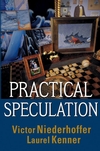| Home | About Us | Resources | Archive | Free Reports | Market Window |
The Penny-Pincher’s Guide to TradingBy
Saturday, June 17, 2006
Vic’s former partner, Steve Wisdom, uses the following technique when buying a car. “The way to beat car dealers, I learned many years ago, is to show up looking indigent, then fanatically beat down the purchase price while appearing indifferent or uncomprehending of the finance angle. Dealers will assume they can sell you the car for no margin and make it up on the back end by putting you ‘on the chart’ (i.e., expensive financing). Then show up the next day in normal clothes, take out your checkbook and buy the car for cash.” Steve’s method can be directly applied to the market. A similar technique has been adopted successfully by George Soros, who, to hear him tell it, has never had a successful trade in the market. When Vic used to trade for him, Soros would bemoan his mistakes every day. At the end of each year, at their annual tennis game, Vic would ask, “How bad was it?” Soros would sheepishly smile and murmur something like, “Oh, we were up 87 percent.” In all candor, Vic has never had a satisfactory day of trading either. If Vic makes money on a particular day, it is never enough; he should have traded more heavily. If he loses money, it is even more terrible because he has six kids to support. The point is, always let your counterparts know about your bad trades. Perhaps they will accommodate with you with a better fill next time, just to keep you in the game. More important, if they feel that you are in the chips, they may not be able to resist the all-too-human tendency to endeavor to relieve you of some of the overplus thereof, as they used to say in the nineteenth century. Someone once asked J. Paul Getty, the richest man in the world in the 1960s, why he installed a pay phone in his London home. He answered that a businessman makes a few cents on every dollar of revenue, on average, after paying suppliers, employees, taxes, and debt holders. If he gets in the habit of paying 10 cents more than he receives for each item, he will quickly go out of business. Not only will he lose everything, but a few hundred thousand employees and suppliers also will be out of work. Like most people, Getty found it hard to behave differently in his personal life than he did in his business. So he ran his personal affairs in a businesslike way and did not pay out an inordinate amount. The world’s richest people today—Buffett, Gates, and Soros—seem to follow a similar path. If they find it useful to be economical in their activities, it is probably good for the rest of us. In stock trading, the biggest mistake people make is paying an extra 10 cents or 25 cents out of every dollar in revenue they take in. Time after time Vic has had some manager working for him who loses 100 percent of capital. Invariably, the trades of such managers are highly profitable—before commissions and bid-asked spreads. What happens is that the market and their own money management outmaneuver them. They take in $1, but they pay out $1.10. If they trade often enough, that can be significant by the end of the year, and unfortunately most people do that. Vic has been a relatively active trader for years. During that time, he estimates, he has made well over half a million trades, and has never bought or sold at the market. He always buys at a limit a few ticks below the current bid price and sells a few ticks above the current offer price. Try it, especially on the electronic markets, and see if you do not start out with a better feeling. Good investing, Victor Niederhoffer and Laurel Kenner -From Practical Speculation, Copyright © 2003 By Victor Niederhoffer and Laurel Kenner. Reprinted by arrangement with John Wiley & Sons, Inc.
Market NotesAN AMAZING MOVE… JUST AMAZING
AN AMAZING MOVE… JUST AMAZING When we post a chart in our weekend edition, we try to pass along a word of caution… or even a buying opportunity we see in the markets. That’s not the case today. We’re posting this chart out of sheer amazement. It’s the action in silver during the past two years. Starting November 2005, silver enjoyed one of the greatest bull moves in history… doubling in just seven months. The past month’s action is the opposite. From the peak reached on May 11, silver fell 37% to its recent low. Amazing. Still want to trade silver futures? The past two years in silver:
|
Recent Articles
|


